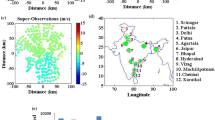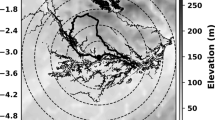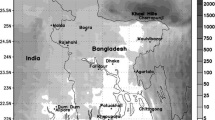Abstract
This study assesses the impact of Doppler weather radar (DWR) data (reflectivity and radial wind) assimilation on the simulation of severe thunderstorms (STS) events over the Indian monsoon region. Two different events that occurred during the Severe Thunderstorms Observations and Regional Modeling (STORM) pilot phase in 2009 were simulated. Numerical experiments—3DV (assimilation of DWR observations) and CNTL (without data assimilation)—were conducted using the three-dimensional variational data assimilation technique with the Advanced Research Weather Research and Forecasting model (WRF-ARW). The results show that consistent with prior studies the 3DV experiment, initialized by assimilation of DWR observations, performed better than the CNTL experiment over the Indian region. The enhanced performance was a result of improved representation and simulation of wind and moisture fields in the boundary layer at the initial time in the model. Assimilating DWR data caused higher moisture incursion and increased instability, which led to stronger convective activity in the simulations. Overall, the dynamic and thermodynamic features of the two thunderstorms were consistently better simulated after ingesting DWR data, as compared to the CNTL simulation. In the 3DV experiment, higher instability was observed in the analyses of thermodynamic indices and equivalent potential temperature (θ e) fields. Maximum convergence during the mature stage was also noted, consistent with maximum vertical velocities in the assimilation experiment (3DV). In addition, simulated hydrometeor (water vapor mixing ratio, cloud water mixing ratio, and rain water mixing ratio) structures improved with the 3DV experiment, compared to that of CNTL. From the higher equitable threat scores, it is evident that the assimilation of DWR data enhanced the skill in rainfall prediction associated with the STS over the Indian monsoon region. These results add to the body of evidence now which provide consistent and notable improvements in the mesoscale model results over the Indian monsoon region after assimilating DWR fields.













Similar content being viewed by others
References
Abhilash S, Das S, Kalsi SR, Das Gupta M, Mohankumar K, George JP, Banerjee SK, Thampi SB, Pradhan D (2007) Impact of Doppler radar wind in simulating the intensity and propagation of rainbands associated with mesoscale convective complexes using MM5-3DVAR System. Pure appl Geophys 164:1491–1509
Air Weather Service (AWS) Technical Report 79/006 (1990) The use of the Skew T, Log P diagram in analysis and forecasting, air weather service. Scott AFB, Illinois
Anthes RA (1976) Numerical prediction of severe storms—certainty, possibility, or dream? Bull Am Meteorol Soc 57:423–435
Barker DM, Huang W, Guo YR, Bourgeois A, Xiao XN (2004) A three-dimensional variational data assimilation system for MM5: implementation and initial results. Mon Weather Rev 132:897–914
Brooks HE, Wilhelmson RB (1992) Numerical simulation of a low-precipitation supercell thunderstorm. Meteorol Atmos Phys 49:3–17
Chang H, Kumar A, Niyogi D, Mohanty UC, Chen F, Dudhia J (2009) The role of land surface processes on the mesoscale simulation of the July 26, 2005 heavy rain event over Mumbai, India. Glob Planet Change 67:87–103
Chaudhuri S, Middey A (2009) The applicability of bipartite graph model for thunderstorms forecast over Kolkata. Adv Meteorol. doi:10.1155/2009/270530
Das S, Abhilash S, Das Gupta M, George JP, Kalsi SR, Banerjee SK, Thampi SB, Pradhan D, Mohankumar K (2006) Assimilation of Doppler weather radar wind in a mesoscale model and their impact on simulation of thunderstorms and severe weather systems. Report no. NMRF/RR/01/2006, 120 pages, Published by NCMRWF, A-50, Sector-62, NOIDA, India 201307
Das S, Mohanty UC, Tyagi A, Sikka DR, Joseph PV, Rathore LS, Habib A, Baidya SK, Sonam K, Sarkar A (2014) The SAARC STORM: a coordinated field experiment on severe thunderstorm observations and regional modeling over the South Asian Region. Bull Am Meteorol Soc 95:603–617
Deng A, Stauffer DR (2006) On improving 4-km mesoscale model simulations. J Appl Meteorol Climatol 45:361–381
Desai BN (1950) Mechanism of Nor’wester of Bengal. IJMG 1, No-1, pp 74
Farely RD, Wang S, Orville HD (1992) A comparison of 3D model results with observations for an isolated CCOPE thunderstorm. Meteorol Atmos Phys 49:187–207
Galway JG (1956) The lifted index as a predictor of latent instability. Bull Am Meteorol Soc 43:528–529
Holton J (1994) An introduction to dynamic meteorology, 4th edn. Elsevier Academic Press, Amsterdam 290 pp
Jankov I, Gallus WA Jr, Segal M, Shaw B, Koch SE (2005) The impact of different WRF model physical parameterizations and their interactions on warm season MCS rainfall. Weather Forecast 20:1048–1060
Jianfeng G, Xiao Q, Kuo YH, Barker D, Jishan X, Xiaoxing M (2005) Assimilation and simulation of typhoon Rusa (2002) using the WRF system. Adv Atmos Sci 22:415–427
Koch SE, Ferrier B, Stolinga M, Szoke E, Weiss SJ, Kain JS (2005) The use of simulated radar reflectivity fields in the diagnosis of mesoscale phenomena from high-resolution WRF model forecasts. Preprints, 11th conference on mesoscale processes, Albuquerque, NM
Latha R, Murthy BS (2011) Boundary layer signatures of consecutive thunderstorms as observed by Doppler sodar over western. India Atmos Res 99:230–240
Lean HW, Clark PA, Dixon M, Roberts NM, Fitch A, Forbes R, Halliwell C (2008) Characteristics of high resolution versions of the Met Office Unified Model for forecasting convection over the United Kingdom. Mon Weather Rev 136:3408–3424
Litta AJ, Mohanty UC, Das S, Idicula SM (2012) Numerical simulation of severe local storms over east India using WRF–NMM mesoscale model. Atmos Res. doi:10.1016/j.atmosres.2012.04.015
Lopez L, Garcia-Ortega E, Sanchez JL (2007) A short-term forecast model for hail. Atmos Res 83:176–184
May PT, Rajopadhyaya DK (1999) Vertical velocity characteristics of deep convection over Darwin, Australia. Mon Weather Rev 127:1056–1077
Mohanty UC, Routray A, Krishna KO, Kiran Prasad S (2012) A study on simulation of heavy rainfall events over Indian region with ARW-3DVAR modeling system. Pure appl Geophys 169:381–399
Morgan G (1992) THETAPLOT, an equivalent potential temperature diagram. Meteorol Atmos Phys 47:259–265
Mukhopadhyay P, Mahakur M, Singh HAK (2009) The interaction of large scale and mesoscale environment leading to formation of intense thunderstorms over Kolkata Part I: Doppler radar and satellite observations. J Earth Syst Sci 118:441–466
Neumann CJ (1971) The thunderstorm forecasting system at the Kennedy Space Center. J Appl Meteorol 10:921–936
Niyogi D, Holt T, Zhong S, Pyle PC, Basara J (2006) Urban and land surface effects on the 30 July 2003 mesoscale convective system event observed in the Southern Great Plains. J Geophys Res 111:D19107. doi:10.1029/2005JD006746
Parrish DF, Derber JC (1992) The National Meteorological Center’s spectral statistical interpolation analysis system. Mon Weather Rev 120:1747–1763
Rai Sircar NC (1957) On the forecasting of Nor’westers in Gangetic West Bengal. Ind J Meteorol Geophys 8:21–32
Rasmussen RM, Wilhelmson RB (1983) Relationships between storm characteristics and 1200GMT hodographs, low-level shear and stability. Preprints, 13th conference on severe local storms, Tulsa. Am Meteorol Soc, pp 55–58
Richardson LF (1922) Weather prediction by numerical process. Cambridge University Press, London, p 236
Routray A (2007) Radar data assimilation over Indian region using WRF–VAR system. Scientific report, February 2007, MMM Division, NCAR, Boulder, CO 80301, USA, 27 pp
Routray A, Mohanty UC, Rizvi SRH, Niyogi D, Krishna KO, Pradhan D (2010) Impact of Doppler weather radar data on numerical forecast of Indian monsoon depressions. Q J R Meteorol Soc. doi:10.1002/qj.678
Routray A, Mohanty UC, Krishna KO, Prasad SK (2013) Improvement of monsoon depressions forecast with assimilation of Indian DWR data using WRF–3DVAR analysis system. doi:10.1007/s00024-013-0648-z
Roy Bhowmik SK, Sen Roy S, Srivastava K, Mukhopadhay B, Thampi SB, Reddy YK, Singh H, Venkateswarlu S, Adhikari S (2011) Processing of Indian Doppler weather radar data for mesoscale applications. Meteorol Atmos Phys. doi:10.1007/s007030100120x
Schultz P (1989) Relationships of several stability indices to convective weather events in northeast Colorado. Weather Forecast 4:73–80
Skamarock WC, Klemp JB, Dudhia J, Gill DO, Barker DM, Duda M, Huang X-Y, Wang W, Powers JG (2008) A description of the advanced research WRF Version 3. NCAR technical note. www.wrf-model.org
Srivastava K, Roy Bhowmik SK, Sen Roy S, Thampi SB, Reddy YK (2010) Simulation of high impact convective events over Indian region by ARPS model with assimilation of Doppler weather radar radial velocity and reflectivity. Atmosfera 23:53–73
Tyagi B, Naresh Krishna V, Satyanarayana ANV (2011) Skill of Thermodynamic indices for forecasting pre-monsoon thunderstorms over Kolkata during STORM pilot phase 2006-2008. Nat Hazards 56:681–698. doi:10.1007/s11069-010-9582-x
Tyagi B, Satyanarayana ANV Naresh, Krishna V (2013) Thermodynamical structure of atmosphere during pre-monsoon thunderstorm season over Kharagpur as revealed by STORM data. Pure appl Geophys 170:675–687
Vaidya SS, Kulkarni JR (2007) Simulation of heavy precipitation over Santacruz, Mumbai on 26 July 2005, using mesoscale model. Meteorol Atmos Phys 98:55–66
Wakimoto RM, Murphey HV, Fovell RG, Lee W-C (2004) Mantle echoes associated with deep convection: observations and numerical simulations. Mon Weather Rev 132:1701–1720
Wang S, Yongfu Q (2001) Basic characteristic of surface heat field in 1998 and the possible connection with the SCS summer monsoon onset. Acta Meteorol Sin 59:31–40
Weiss SJ, Bright DR, Kain JS, Levit JJ. Pyle ME, Janjic ZI, Ferrier BS, Du J (2006) Complementary use of short-range ensemble and 455 KM WRF–NMM model guidance for severe weather forecasting at the Storm Prediction Centre. Preprints, 23rd conference severe local storms. ST Louis MO. Am Meteorol Soc CD-ROM. 8.5
Xiao Q, Sun J (2007) Multiple-radar data assimilation and short-range quantitative precipitation forecasting of a squall line observed during IHOP_2002. Mon Weather Rev 135:3381–3404
Xiao Q, Kuo Y-H, Sun J, Lee W-C, Lim E, Guo Y-R, Barker DM (2005) Assimilation of Doppler radar observations with a regional 3DVAR system: impact of Doppler velocities on forecasts of a heavy rainfall case. J Appl Meteorol 44:768–788
Xiao Q, Kuo Y-H, Sun J, Lee W-C, Barker DM, Lim E (2007) An approach of radar reflectivity data assimilation and its assessment with the inland QPF of Typhoon Rusa (2002) at landfall. J Appl Meteorol Climatol 46:14–22
Zhang F, Weng Y, Sippel JA, Meng Z, Bishop CH (2009) Cloud-resolving hurricane initialization and prediction through assimilation of Doppler radar observations with an ensemble Kalman filter. Mon Weather Rev 137:2105–2125
Zhang M, Zhang F, Huang X-Y, Zhang X (2011) Intercomparison of an ensemble Kalman filter with three- and four-dimensional variational data assimilation methods in a limited-area model over the month of June 2003. Mon Weather Rev 139:566–572
Acknowledgments
This work has been carried out with financial aid from the Department of Science and Technology (DST), Govt. of India, and is duly acknowledged here. DN benefitted from NSF CAREER grant (AGS-847472; Dr. A. Bamzai). Authors acknowledge the use of WRF–ARW and 3DVAR developed by the National Center for Atmospheric Research (NCAR), USA. The use of TRMM products is also duly acknowledged. The authors acknowledge IMD for providing the necessary datasets used in the assimilation and validation of the results. Authors sincerely thank Dallas Staley for her outstanding editing of the manuscript. Further the authors extend their sincere thanks to anonymous reviewers for their valuable comments and suggestions in improving the manuscript.
Author information
Authors and Affiliations
Corresponding author
Rights and permissions
About this article
Cite this article
Kiran Prasad, S., Mohanty, U.C., Routray, A. et al. Impact of Doppler weather radar data on thunderstorm simulation during STORM pilot phase—2009. Nat Hazards 74, 1403–1427 (2014). https://doi.org/10.1007/s11069-014-1250-0
Received:
Accepted:
Published:
Issue Date:
DOI: https://doi.org/10.1007/s11069-014-1250-0




